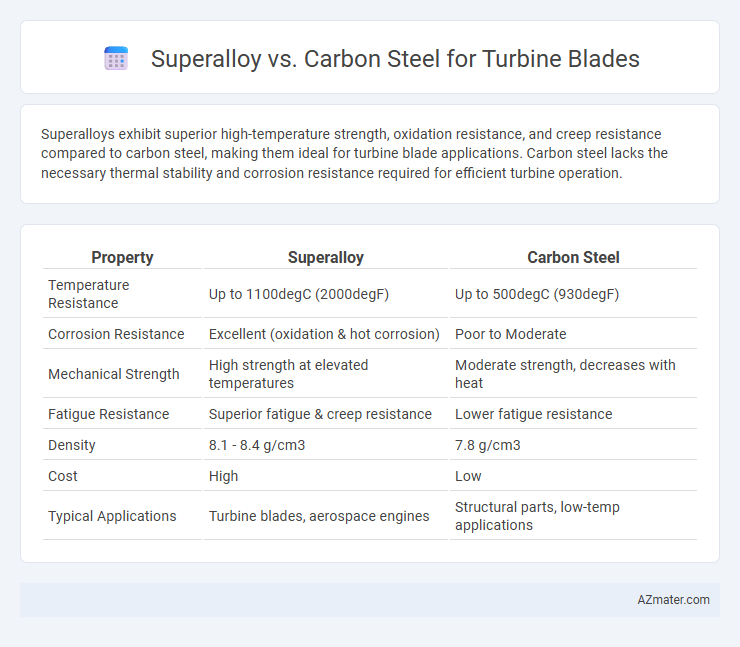Superalloys exhibit superior high-temperature strength, oxidation resistance, and creep resistance compared to carbon steel, making them ideal for turbine blade applications. Carbon steel lacks the necessary thermal stability and corrosion resistance required for efficient turbine operation.
Table of Comparison
| Property | Superalloy | Carbon Steel |
|---|---|---|
| Temperature Resistance | Up to 1100degC (2000degF) | Up to 500degC (930degF) |
| Corrosion Resistance | Excellent (oxidation & hot corrosion) | Poor to Moderate |
| Mechanical Strength | High strength at elevated temperatures | Moderate strength, decreases with heat |
| Fatigue Resistance | Superior fatigue & creep resistance | Lower fatigue resistance |
| Density | 8.1 - 8.4 g/cm3 | 7.8 g/cm3 |
| Cost | High | Low |
| Typical Applications | Turbine blades, aerospace engines | Structural parts, low-temp applications |
Introduction: The Importance of Material Choice in Turbine Blades
Turbine blades demand materials with exceptional strength, high-temperature resistance, and durability to withstand extreme operating conditions. Superalloys, characterized by their superior creep resistance and oxidation stability at elevated temperatures, outperform carbon steel in maintaining structural integrity within gas turbines. Selecting superalloys over carbon steel significantly enhances turbine efficiency, lifespan, and safety under thermal and mechanical stress.
Overview of Superalloys and Carbon Steel
Superalloys, primarily composed of nickel, cobalt, or iron, are designed to maintain exceptional strength and corrosion resistance at high temperatures, making them ideal for turbine blades operating in extreme environments. Carbon steel, consisting mainly of iron and carbon, offers good mechanical properties and cost-effectiveness but lacks the high-temperature performance and oxidation resistance required for turbine blade applications. The superior creep resistance, thermal stability, and oxidation resistance of superalloys significantly outperform carbon steel in demanding turbine conditions.
Mechanical Properties Comparison
Superalloys exhibit superior mechanical properties compared to carbon steel for turbine blades, including higher tensile strength, excellent creep resistance at elevated temperatures, and better fatigue durability. Carbon steel, while cost-effective, lacks the ability to maintain structural integrity under extreme thermal and mechanical stresses experienced in turbine environments. The enhanced creep rupture strength of superalloys ensures longer service life and improved performance in high-temperature turbine applications.
High-Temperature Performance
Superalloys exhibit superior high-temperature performance compared to carbon steel, maintaining strength and corrosion resistance at temperatures exceeding 900degC, making them ideal for turbine blades exposed to extreme heat. Carbon steel, while cost-effective, suffers from rapid oxidation and loss of mechanical properties above 500degC, limiting its application in high-temperature environments. The advanced metallurgy of superalloys enhances creep resistance and thermal stability, crucial for turbine blade longevity and efficiency.
Corrosion and Oxidation Resistance
Superalloys exhibit superior corrosion and oxidation resistance compared to carbon steel, making them ideal for turbine blades operating in extreme high-temperature environments. Their complex composition, including elements such as nickel, chromium, and cobalt, forms stable oxide layers that prevent material degradation and maintain structural integrity. In contrast, carbon steel rapidly corrodes and oxidizes under such conditions, leading to reduced blade lifespan and compromised performance.
Fatigue and Creep Resistance
Superalloys exhibit superior fatigue and creep resistance compared to carbon steel, making them ideal for turbine blade applications subjected to high temperatures and cyclic stresses. Their complex microstructure and alloying elements such as nickel, cobalt, and chromium enhance mechanical strength and oxidation resistance under prolonged thermal exposure. Carbon steel, while cost-effective, lacks the high-temperature stability and fatigue endurance necessary for turbine blade performance, limiting its use in advanced gas turbine environments.
Manufacturability and Machinability
Superalloys offer superior high-temperature strength and oxidation resistance for turbine blades but present challenges in manufacturability due to their hardness and work-hardening tendencies, requiring advanced casting and forging techniques. Carbon steel, while easier to machine and more cost-effective to manufacture with conventional methods, lacks the thermal and mechanical properties needed for turbine blade applications. Machinability of superalloys demands specialized tooling and slow cutting speeds to avoid tool wear and maintain precision, whereas carbon steel allows faster machining with standard tools but is unsuitable for high-performance turbine environments.
Cost Implications and Availability
Superalloys for turbine blades exhibit superior high-temperature strength and corrosion resistance but come with significantly higher material and manufacturing costs compared to carbon steel. Carbon steel offers greater affordability and easier availability but lacks the necessary thermal stability and oxidation resistance required for high-performance turbine operations. The choice impacts overall production budgets and supply chain logistics, with superalloys demanding specialized sourcing and fabrication processes.
Applications in Modern Turbine Technology
Superalloys, primarily nickel-based, dominate modern turbine blade applications due to their exceptional high-temperature strength, oxidation resistance, and creep resistance, enabling operation in extreme environments beyond 1100degC. Carbon steel, while cost-effective and strong at lower temperatures, lacks the thermal stability and corrosion resistance required for high-efficiency gas turbine engines. Advanced superalloy compositions with precise microstructural control improve turbine blade lifespan and performance, critical for aerospace and power generation industries.
Conclusion: Optimal Material for Turbine Blade Efficiency
Superalloys exhibit superior high-temperature strength, oxidation resistance, and creep resistance compared to carbon steel, making them the optimal choice for turbine blade efficiency. Carbon steel, while cost-effective and easier to manufacture, lacks the thermal stability and durability required for the extreme operating conditions in turbine engines. Therefore, superalloys ensure enhanced performance, longer blade life, and improved overall turbine efficiency under high-stress, high-temperature environments.

Infographic: Superalloy vs Carbon steel for Turbine blade
 azmater.com
azmater.com